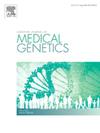Autosomal recessive frameshift variant broadens HECW2-related disease spectrum
IF 1.7
4区 医学
Q3 GENETICS & HEREDITY
引用次数: 0
Abstract
The HECW2 gene encodes a HECT (homologous to E6-AP carboxy terminus)-type E3 ubiquitin ligase that plays a critical role in neurodevelopment. Pathogenic variants in HECW2 are associated with a neurodevelopmental disorder characterized by hypotonia, seizures, and absent language (NDHSAL; OMIM #617268), typically inherited in an autosomal dominant pattern. However, recent evidence suggests that some variants in HECW2 gene may cause the disease with autosomal recessive inheritance.
Here, we report a 6-year-old female proband of consanguineous Afghan descent who presented with severe microcephaly, hypotonia, failure to thrive, recurrent seizures, global neurodevelopmental delay, and brain MRI findings of significant cerebral and cerebellar atrophy. Whole-exome sequencing revealed a novel homozygous frameshift variant in HECW2 (c.3601_3602insT, p.Y1201Lfs∗7, ClinVar: SCV006279594) in this patient. In silico analyses and Sanger validation confirmed the pathogenicity of this variant and its autosomal recessive inheritance, with both parents being heterozygous carriers but clinically unaffected. This frameshift variant likely results in nonsense-mediated decay (NMD) of the mRNA, suggesting a loss-of-function mechanism distinct from the mechanism implicated in missense variants that causing the disease with autosomal dominant inheritance.
This study expands the phenotype and genetic spectrum of HECW2-related disorders and highlights the importance of recognizing autosomal recessive inheritance patterns. The findings emphasize the need for comprehensive genetic analyses, especially in consanguineous populations, and underscore the value of considering null variants in HECW2 when evaluating severe neurodevelopmental phenotypes. Further studies exploring the molecular mechanisms of HECW2 variants are essential to deepen our understanding of its role in neurodevelopment and refine diagnostic and therapeutic approaches.
常染色体隐性移码变异拓宽了hecw2相关的疾病谱
HECW2基因编码HECT(与E6-AP羧基端同源)型E3泛素连接酶,在神经发育中起关键作用。HECW2的致病变异与神经发育障碍有关,其特征是张力低下、癫痫发作和语言缺失(NDHSAL;OMIM #617268),通常以常染色体显性模式遗传。然而,最近的证据表明,HECW2基因的某些变异可能导致常染色体隐性遗传。在这里,我们报告了一名6岁的阿富汗裔女性先证,她表现出严重的小头畸形、张力低下、发育不全、反复发作、全身神经发育迟缓,以及脑部MRI表现出明显的大脑和小脑萎缩。全外显子组测序结果显示,该患者的HECW2基因(c.3601_3602insT, p.Y1201Lfs * 7, ClinVar: SCV006279594)存在一个新的纯合移码变异。计算机分析和Sanger验证证实了该变异的致病性及其常染色体隐性遗传,父母双方都是杂合携带者,但临床未受影响。这种移码变异可能导致mRNA的无义介导的衰变(NMD),表明其功能丧失机制不同于引起常染色体显性遗传疾病的错义变异所涉及的机制。本研究扩展了hecw2相关疾病的表型和遗传谱,并强调了识别常染色体隐性遗传模式的重要性。研究结果强调需要进行全面的遗传分析,特别是在近亲人群中,并强调在评估严重的神经发育表型时考虑HECW2的零变异的价值。进一步研究HECW2变异的分子机制对于加深我们对其在神经发育中的作用的理解以及改进诊断和治疗方法至关重要。
本文章由计算机程序翻译,如有差异,请以英文原文为准。
求助全文
约1分钟内获得全文
求助全文
来源期刊
CiteScore
4.10
自引率
0.00%
发文量
193
审稿时长
66 days
期刊介绍:
The European Journal of Medical Genetics (EJMG) is a peer-reviewed journal that publishes articles in English on various aspects of human and medical genetics and of the genetics of experimental models.
Original clinical and experimental research articles, short clinical reports, review articles and letters to the editor are welcome on topics such as :
• Dysmorphology and syndrome delineation
• Molecular genetics and molecular cytogenetics of inherited disorders
• Clinical applications of genomics and nextgen sequencing technologies
• Syndromal cancer genetics
• Behavioral genetics
• Community genetics
• Fetal pathology and prenatal diagnosis
• Genetic counseling.

 求助内容:
求助内容: 应助结果提醒方式:
应助结果提醒方式:


